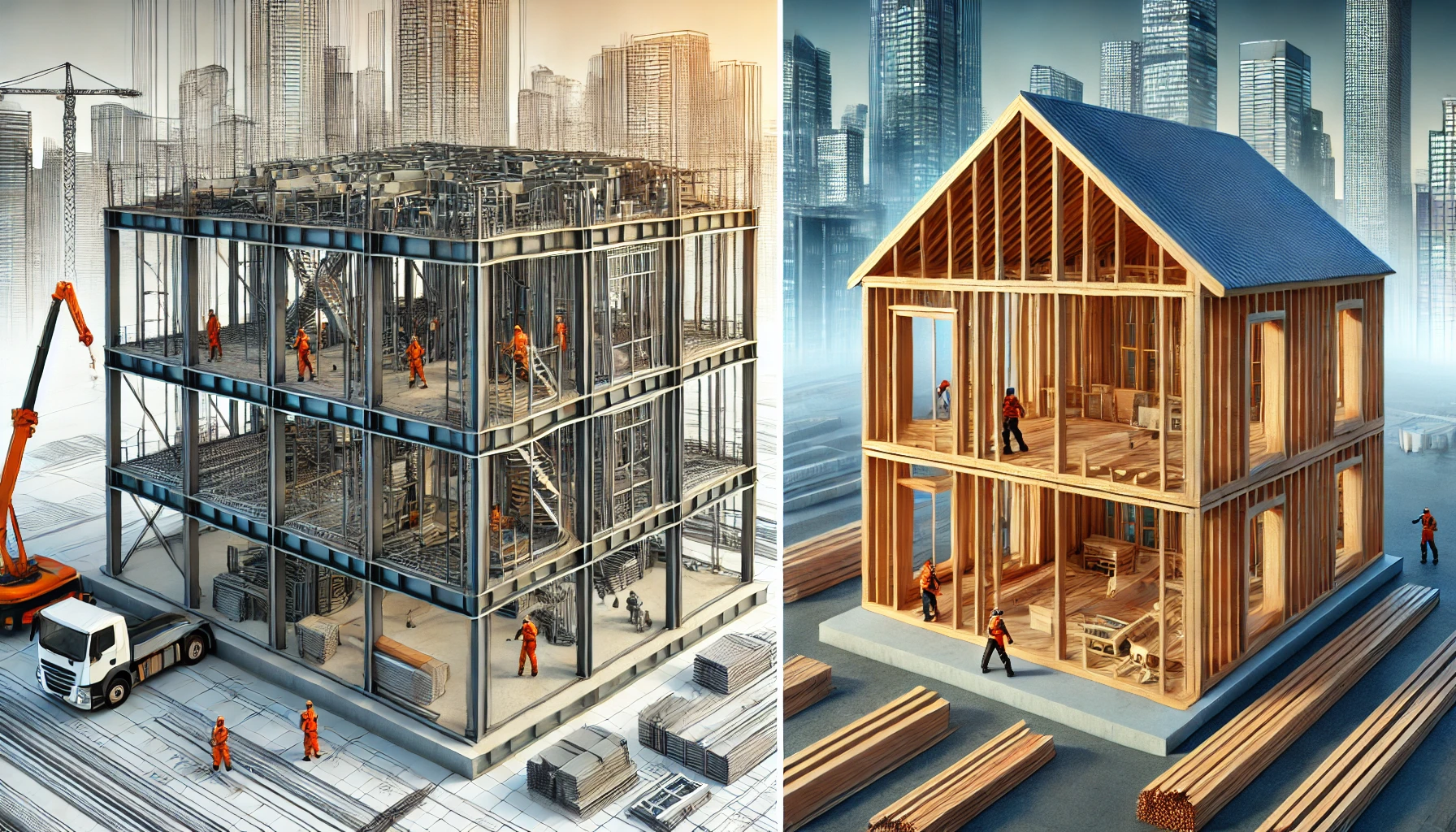The choice between steel frame and wood frame construction is a crucial decision in modern building projects. Both systems offer efficiency, sustainability, and cost savings, but each has distinct advantages and limitations depending on the project’s location, climate, and purpose.
In this article, we’ll compare steel frame and wood frame construction, analyzing their strength, cost, environmental impact, durability, and suitability for different building types.
What is Steel Frame Construction?
Steel frame construction uses galvanized steel profiles to form the structural skeleton of a building. This method is widely used in industrial, commercial, and residential projects due to its strength and durability.
How It Works:
- Steel beams and columns are prefabricated in a factory.
- The components are transported to the site and assembled using bolts and welding.
- Walls, insulation, and finishes are added to complete the structure.
Where It’s Commonly Used:
- Skyscrapers and high-rise buildings
- Industrial warehouses and factories
- Residential homes in regions with extreme weather
What is Wood Frame Construction?
Wood frame construction uses timber beams and panels to create the building’s support structure. It is a popular method for houses, apartments, and low-rise buildings, especially in North America and Europe.
How It Works:
- Wooden studs and beams are cut, assembled, and nailed together to form the frame.
- Plywood or oriented strand board (OSB) is used to cover the frame.
- The structure is insulated and finished with drywall, siding, or other materials.
Where It’s Commonly Used:
- Single-family homes in the U.S., Canada, and Scandinavia
- Cabins and eco-friendly buildings
- Low-rise apartment buildings
Comparison: Steel Frame vs. Wood Frame
1. Strength and Durability
- Steel Frame: Extremely strong and resistant to fire, moisture, termites, and extreme weather conditions (hurricanes, earthquakes, and heavy snow).
- Wood Frame: Strong but susceptible to fire, termites, and moisture damage if not properly treated.
🔹 Winner: Steel Frame (for long-term durability and resilience).
2. Cost and Affordability
- Steel Frame: Higher initial material costs, but requires less maintenance and lasts longer.
- Wood Frame: Lower initial costs, but may require more maintenance and repairs over time.
🔹 Winner: Wood Frame (for initial affordability, but steel wins in long-term savings).
3. Speed of Construction
- Steel Frame: Requires specialized labor, but prefabrication speeds up construction.
- Wood Frame: Easier to assemble, making it faster for smaller projects.
🔹 Winner: Wood Frame (for quick construction, but steel is faster for large-scale prefabrication).
4. Sustainability and Environmental Impact
- Steel Frame: 100% recyclable, but steel production emits more CO₂.
- Wood Frame: Sustainable if sourced from responsibly managed forests, and has a lower carbon footprint.
🔹 Winner: Wood Frame (for eco-friendliness, but only if sourced sustainably).
5. Fire and Pest Resistance
- Steel Frame: Fire-resistant and not affected by termites, mold, or rot.
- Wood Frame: Flammable and prone to termite damage, requiring additional treatments.
🔹 Winner: Steel Frame (for superior resistance to fire and pests).
6. Energy Efficiency
- Steel Frame: Conducts heat more easily, requiring additional insulation.
- Wood Frame: Naturally better at insulation, making it more energy-efficient in cold climates.
🔹 Winner: Wood Frame (for insulation, but steel can be improved with proper materials).
Which One Should You Choose?
🔹 Choose Steel Frame if:
✔ You need a strong, durable, and fire-resistant structure.
✔ The building is located in an area prone to hurricanes, earthquakes, or termites.
✔ You prefer a long-term investment with lower maintenance costs.
🔹 Choose Wood Frame if:
✔ You are building a single-family home or small residential project.
✔ You need a quick and cost-effective solution.
✔ Sustainability and natural materials are a priority.
Conclusion: Finding the Right Balance
Both steel frame and wood frame construction have their advantages. Steel offers strength, durability, and fire resistance, while wood provides affordability, energy efficiency, and sustainability.
The best choice depends on the project’s size, location, budget, and environmental concerns. In some cases, a hybrid approach—using both steel and wood—can combine the best of both worlds.
Would you choose steel or wood for your next construction project?

